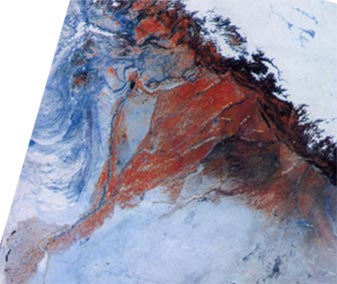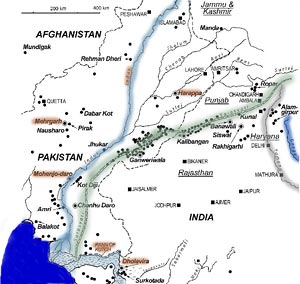Reviving the Sarasvati
BY: SUN STAFF

Sep 8, GUJURAT, INDIA (SUN) — In Gujarat today, a special celebration is being held on the auspicious Rishi Panchami day in honor of the Sarasvati-Narmada Mahasangam (confluence). The transcendental river Sarasvati, spoken of throughout the Vedas, has long been disappeared from view. Many years of archeological, scientific and spiritual study have been conducted to locate and prove the river's physical whereabouts. As a result, the Sarasvati's riverbed has been located, and many scientists and spiritualists around the world are in agreement as to the findings.
On Thursday, waters from the Narmada canal, part of an ambitious Narmada public works project, will be diverted near the holy town of Siddhpur in north Gujarat. Devotees will fill their lota pots with waters from different sacred rivers across the state, converging on the place where River Sarasvati will be revived. The government there has organized celebrations on the banks of Sarasvati, and three special trains have been provided to bring pilgrims from Ahmedabad and Palanpur.
According to one government spokesperson, "Centuries ago, the banks of the ancient Saraswati river at Siddhpur were known as a pilgrimage place and thousands of Hindu devotees from across the country used to visit it. In recent centuries, however, the holy river has remained dried up perennially. Now that it will be filled with the Narmada waters, devotees will be able to perform religious rites."
The Sarasvati River has been mentioned in many Vedas, including Yajur Veda, Atharva Veda, Manu Samhita, Mahabharata, and the Puranas. The Rig Veda mentions the Sarasvati River more than 50 times, describing the descent of the ancient Sarasvati River from its source in the Himalayas to the Arabian Sea:
Pra ksodasa dhayasa sasra
esa Sarasvati dharunamayasi puh
prababadhana rathyeva yati
visa apo mahina sindhuranyah
"Pure in her course from the mountains to the ocean, alone of streams Sarasvati hath listened."
Rig Veda 07.095.01.1-2

Rig Veda describes Saraswati as the seventh river of the Sindhu-Saraswati river system, thus the name 'Saptsindhu', for the region bounded by rivers Saraswati in the east and Sindhu (Indus) in the west.
Satellite imagery (see above image) shows the entire Indus-Sarasvati river system and the position of the Sarasvati riverbed. In the picture below, we see the Indus River outlined in blue on the left, and the Sarasvati outlined in green, on the right. The black dots mark various archeological sites along the Sarasvati's riverbanks.
In mundane terms, the River Sarasvati disappeared from view because her major source of glacier waters from in west Garhwal disappeared. Satellite and 3D images however, have clearly established the entire course of this holy river over a distance of 1,600 km, from Har-ki-Dun (Uttaranchal) to Gujurat, where the water met the ocean at the city of Dwarka. The waters flowed parallel to the Yamuna river for some distance, then joined it, proceeding south as the Saraswati.
The creation of the Saraswati-Narmada confluence is but one of many steps in the India government's extensive plan to interlink almost all the major rivers in the country. By doing so, the government hopes to avoid future shortages of water for individual regions on the subcontinent. Being described as a tribute to the excellence of Indian scientists, engineers and scholars, the six-stage, many year project will link up waters from the Brahmaputra and the Ganga, the Ganga and the Sharda, the Sutlej and the Saraswati, the Ganga and the Mahanadi, the Godavari, the Krishna and the Kaveri.
For more information:
http://www.archaeologyonline.net/artifacts/scientific-verif-vedas.html
